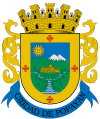Popayán, Colombia
| Popayán | |||
|---|---|---|---|
| City | |||

City Center and Plaza
|
|||
|
|||
| Nickname(s): "The White City" | |||
 Location of the City and municipality of Popayán in the Cauca Department. |
|||
| Location in Colombia | |||
| Coordinates: 2°27′15″N 76°36′33″W / 2.45417°N 76.60917°WCoordinates: 2°27′15″N 76°36′33″W / 2.45417°N 76.60917°W | |||
| Country |
|
||
| Departamento | Cauca | ||
| Founded | 13 January 1537 | ||
| Founded by | Sebastián de Belalcázar | ||
| Government | |||
| • Mayor | Cesar Cristian Gómez Castro (2016-2019) |
||
| Area | |||
| • City | 483.11 km2 (186.53 sq mi) | ||
| Elevation | 1,760 m (5,770 ft) | ||
| Population (2017) | |||
| • City | 439,257 (Metropolitan) | ||
| • Density | 584.90/km2 (1,514.9/sq mi) | ||
| • Urban | 252,570 | ||
| • Metro | 282,561 | ||
| Demonym(s) | Payanés | ||
| Time zone | EST (UTC-05) | ||
| Postal code | 190001-19 | ||
| Area code(s) | +2 | ||
| Website | Official website | ||
Popayán is the capital of the Colombian department of Cauca. It is located in southwestern Colombia between Colombia's Western Mountain Range and Central Mountain Range. It has a population of 258,653 people, a territorial extension of 512 km2, is located 1760 meters above sea level, and has an average temperature of 18/20 °C.
This town is well known for its colonial architecture and its contributions to Colombian cultural and political life. It is also known as the "white city" due to the color of the most of colonial houses and places in the city downtown, where several churches are located, such as San Francisco, San José, Belén, Santo Domingo, San Agustín, and the Catedral Basílica Nuestra Señora de la Asunción, known locally as "La Catedral". The city's cathedral was home to the Crown of the Andes, a 16th-century Marianist devotional object featuring emeralds taken from the captured Inca Emperor Atahualpa before its sale to finance local health care institutions.
Popayán has been home to seventeen Colombian presidents, as well as noted poets, painters, and composers. The University of Cauca (est. 1827), one of Colombia's oldest and most distinguished institutions of higher education, is located here; that is why Popayán is also known as the "University City." Nearby is Puracé National Natural Park, a geothermal wonderland of hot springs, waterfalls, and an inactive volcano from which the park derives its name. The nearest large city is Cali, in the Valle del Cauca Department, to the north of Cauca.
Much of the city's original splendor was destroyed on 31 March 1983, when an earthquake toppled many buildings. Though many of them were rebuilt and repaired, the heart of the city still bears ruins and empty lots since the disaster. In 2005, Popayán was declared by the UNESCO as the first city of gastronomy because of its variety and meaning to the intangible patrimony of Colombian culture. The culinary history of the Cauca Department was chosen because of their maintaining of traditional methods of food preparation which has been passed over through different generations orally. On 2009 September 28, UNESCO also declared the processions of the Easter Week processions as a Masterpiece of the Oral and Intangible Patrimony of Humanity.
...
Wikipedia



